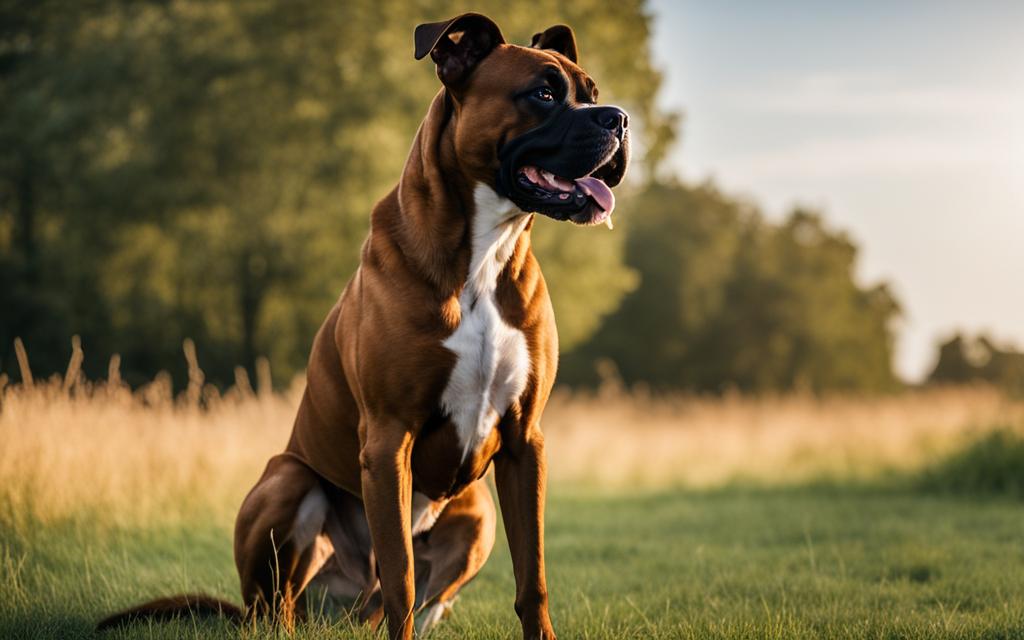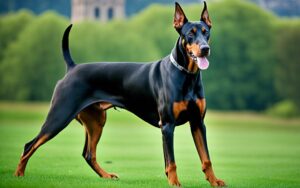
Did you know that Boxer Dog breed are one of the most popular dog breeds in the United States? With their muscular build, intelligent nature, and playful demeanor, it’s no surprise that Boxers have captured the hearts of many dog lovers. Whether you are considering adding a Boxer to your family or simply want to learn more about this fascinating breed, you’ve come to the right place. In this comprehensive guide, we will explore the characteristics, care tips, and training strategies that will help you provide the best life for your Boxer companion.
Key Takeaways: Boxer Dog Breed
- Boxers are one of the most popular dog breeds in the United States.
- Their muscular build, intelligence, and playful nature make them a favorite among dog lovers.
- Understanding their unique characteristics and providing proper care are essential for a happy and healthy Boxer.
- Boxers require exercise, mental stimulation, and socialization to thrive.
- When getting a Boxer, consider adoption or choose a reputable breeder who prioritizes the health and well-being of their dogs.
Origin and History of the Boxer Dog Breed
The Boxer is a beloved dog breed with a fascinating origin and history. Developed in Germany in the 19th century, the Boxer descended from the now-extinct Bullenbeisser breed, which was used by hunters for tracking and capturing large game.
In order to create a breed that possessed desired traits, such as strength, agility, and an amiable temperament, the Bullenbeisser was crossed with other breeds like the English Bulldog and Mastiff. This careful breeding resulted in the creation of the modern Boxer, a breed renowned for its athleticism, energy, and striking appearance.
The Boxer’s ancestors played a crucial role in its development, shaping both its physical characteristics and behavioral traits. The influence of the Bullenbeisser can still be seen in the Boxer’s strong and muscular build, as well as its tenacious hunting instincts.
The Boxer’s history as a working dog is a testament to its versatility and intelligence. Originally used for tasks such as pulling carts and livestock herding, the Boxer later found success as a police and military dog. Today, the Boxer’s inherent drive to work and please its owners makes it highly trainable and adaptable to a variety of tasks.
With its rich history and unique lineage, the Boxer has become a well-loved breed that continues to captivate dog enthusiasts around the world.
Boxer Breed Development
| Breed | Role | Contributions to the Boxer Breed |
|---|---|---|
| Bullenbeisser | Hunting | Provided the foundation for the Boxer breed, contributing to its athleticism and hunting instincts. |
| English Bulldog | Companion | Added strength, endurance, and a distinctive square-shaped head to the Boxer’s appearance. |
| Mastiff | Guardian | Influenced the Boxer’s protective nature and provided a calm and composed temperament. |
Physical Characteristics of Boxer Dogs
Boxers are known for their unique physical features that set them apart from other breeds. From their distinct head shape to their muscular build, Boxers have an appearance that is both striking and athletic. Here are some key physical characteristics of Boxer dogs:
Distinctive Head and Jaw
One of the most noticeable features of Boxers is their square-shaped head. Their skull is broad and their muzzle is blunt. Boxers have strong jaws, which contribute to their powerful bite. This characteristic makes them excellent guard dogs and provides them with the ability to protect their loved ones.
Medium to Large Size
Boxers fall into the medium to large size category. Males typically stand between 23-25 inches at the shoulder, while females stand between 21-23 inches. This size range gives them a commanding presence without being overly large. Whether walking down the street or participating in dog shows, Boxers attract attention with their stature.
Weight Range
When it comes to weight, male Boxers generally weigh between 60-70 pounds, while females typically weigh between 50-60 pounds. Their muscular build contributes to their weight, giving them the strength and agility they are known for. However, it’s important to note that individual Boxer dogs may vary slightly in size and weight within these ranges.
Short and Shiny Coat
The Boxer’s coat is short and has a glossy appearance. This low-maintenance coat makes it easier to groom and clean them. Boxers come in various coat colors, with brindle, fawn, and white being the most common. Many Boxers also have white markings on their bodies, adding to their distinct and eye-catching appearance.
| Physical Characteristics | Description |
|---|---|
| Head and Jaw | Square-shaped head, strong jaws |
| Size | Medium to large, males: 23-25 inches, females: 21-23 inches |
| Weight | Males: 60-70 lbs, females: 50-60 lbs |
| Coat | Short, shiny, brindle, fawn, and white with various markings |
Overall, Boxers have a distinctive appearance that showcases their strength, athleticism, and beauty. Their square-shaped head, strong jaws, medium to large size, and short coat all contribute to their unique charm. Whether walking in the park or cuddling at home, Boxer dogs are sure to captivate everyone they meet.
Boxer Dog Temperament and Behavior
Boxers are known for their friendly, playful, and loyal nature. They possess a unique temperament that endears them to many dog lovers. Their friendly and joyful demeanor makes them excellent companions for families and individuals alike. With their intelligence and eagerness to please, they are highly trainable and respond well to positive reinforcement training methods.
Boxers have a lot of energy and require daily exercise and mental stimulation to thrive. Regular physical activities such as walks, runs, or play sessions are essential to keep their minds and bodies engaged. They enjoy interactive games like fetch and agility training, which not only provide exercise but also challenge their problem-solving abilities.
It’s important to note that Boxers have a strong prey drive due to their working dog background. Therefore, it’s best to keep them on a leash or in a securely fenced-in area when outside to prevent them from pursuing small animals or wandering off. Leash training is crucial for their safety and the peace of mind of their owners.
Early socialization plays a vital role in shaping a Boxer’s personality and behavior. Introducing them to various environments, people, and animals from a young age helps them become well-rounded and confident dogs. Boxers thrive in a loving and consistent environment where clear boundaries and expectations are established through positive reinforcement.
Remember that every Boxer is unique, and individual personalities and temperaments can vary. Some may be more reserved, while others may be more outgoing. It’s essential to understand and respect their individual traits and cater to their specific needs through a combination of training, exercise, and mental stimulation.
Overall, Boxers are loyal, affectionate, and intelligent dogs that thrive in a loving and engaging environment. With proper training, socialization, and care, they can become well-behaved and loving members of the family.
Notable Boxer Dog Traits:
- Loyal and Protective
- Playful and Energetic
- Intelligent and Trainable
- Strong Prey Drive
- Requires Daily Exercise and Mental Stimulation
- Needs Early Socialization
Boxer Dog Health and Care
Boxer Dog Breed are a beloved breed, but like any dog, they are susceptible to certain health issues. Being aware of these issues and taking proactive measures to care for your Boxer can help ensure they live a long and healthy life.
Boxer Dog Health Issues
Some common health issues that affect Boxers include:
- Cancer
- Dilated cardiomyopathy (DCM)
- Arrhythmogenic right ventricular cardiomyopathy (ARVC)
- Gastric dilatation-volvulus (GDV)
- Hypothyroidism
- Cranial cruciate ligament disease
“Regular veterinary check-ups and screenings can help detect and address these conditions early on, potentially improving the outcome for your Boxer.”
In addition to regular vet visits, pet owners should have a strong preventative health routine in place. This includes keeping up with vaccinations, maintaining parasite control, and providing a nutritious diet.
Boxer Dog Lifespan
The average lifespan of a Boxer is around 10 to 12 years. It’s important to note that individual dogs may live shorter or longer lives depending on various factors such as genetics, overall health, and lifestyle.
Boxer Dog Grooming
Boxers have a short and smooth coat, which requires minimal grooming. Regular brushing helps remove loose hair and keeps their coat shiny. Additionally, occasional baths and regular nail trimming and teeth brushing are essential for their overall hygiene.
Boxer Dog Nutrition
Feeding your Boxer a balanced and nutritious diet is crucial for their overall health and well-being. Look for high-quality dog food recommended by veterinarians and approved by the Association of American Feed Control Officials (AAFCO). The diet should provide the necessary nutrients and be appropriate for their age, size, and activity level.
“Proper nutrition plays a key role in maintaining your Boxer’s energy levels, strong immune system, and healthy weight.”
Always consult with your veterinarian for specific dietary recommendations and feeding guidelines tailored to your Boxer’s individual needs.
| Health Issue | Description | Treatment |
|---|---|---|
| Cancer | Canine cancer can affect various organs and body systems. | Treatment options may include surgery, chemotherapy, or radiation therapy. |
| Dilated Cardiomyopathy (DCM) | A condition that affects the dog’s heart muscle, causing it to become weakened and enlarged. | Treatment may involve medications to manage symptoms and slow the progression of the disease. |
| Arrhythmogenic Right Ventricular Cardiomyopathy (ARVC) | A hereditary condition that affects the heart’s electrical system, leading to irregular heart rhythms. | Treatment may involve medications to control arrhythmias and manage symptoms. |
| Gastric Dilatation-Volvulus (GDV) | Also known as bloat, this is a life-threatening condition where the stomach twists and traps gas and fluid. | Immediate veterinary intervention is required, and treatment often involves surgery to correct the condition. |
| Hypothyroidism | A hormone deficiency condition that affects the thyroid gland. | Treatment involves thyroid hormone supplementation. |
| Cranial Cruciate Ligament Disease | A common knee injury in dogs that affects the ligaments supporting the knee joint. | Treatment options may include surgery, physical therapy, or pain management. |
Finding a Boxer Dog
When it comes to welcoming a Boxer into your life, there are a few options to consider. The first and most compassionate choice is to adopt a Boxer from a rescue organization or shelter. By doing so, you provide a loving home to a dog in need and make a positive impact on their life. Boxer dog adoption is an opportunity to give a deserving animal a second chance.
However, if you decide to purchase a Boxer from a breeder, it is crucial to conduct thorough research to ensure you choose a reputable breeder. Look for breeders who prioritize ethical practices and the overall health and temperament of their dogs. Reputable Boxer dog breeders will be transparent and honest about the breeding process and will conduct necessary health screenings on their adult dogs.
Take the time to visit the breeder’s facility and meet the puppies’ parents to assess their living conditions and temperament. A nurturing environment is essential for the puppies’ development and well-being. Remember, finding reputable Boxer dog breeders is crucial in ensuring you bring home a happy and healthy puppy.
Whether you choose adoption or working with a breeder, the most important aspect is to prioritize the welfare of the Boxer dog. Responsible ownership starts with making an informed and conscientious decision.
| Option | Advantages | Considerations |
|---|---|---|
| Boxer Dog Adoption |
|
|
| Boxer Dog Breeders |
|
|
“Rescue dogs aren’t broken, they’ve simply experienced more life than other dogs. If they were human, we would call them wise. They would be the ones with tales to tell and stories to write, the ones dealt a bad hand who responded with courage.”
–
Ann White
Boxer Dogs and Apartment Living
Boxer Dog Breed can adapt well to apartment living with the right training and exercise. While their size may not be the sole consideration, it is important to choose a breed that is quiet, low-energy, and sociable towards neighbors.
Training and socialization play a crucial role in managing a Boxer’s behavior both indoors and outdoors. By providing consistent and positive reinforcement training, owners can teach their Boxers how to behave calmly and avoid anxiety-related habits.
Leash training is essential for controlling a Boxer’s energy during walks and ensuring their safety. It helps them build good walking manners and makes it easier to handle them in public areas. Crate training can also be beneficial for apartment living, as it provides a safe and comfortable space for Boxers when owners are away or need them to settle down.
When living in an apartment, it’s important to remember that Boxers are an active breed and require regular exercise to stay physically and mentally stimulated. This can include daily walks, playtime, and interactive toys. Consider dedicating time for activities in nearby parks or dog-friendly areas to provide them with additional space to run and socialize.
Overall, with the right approach to training, exercise, and mental stimulation, Boxers can thrive in apartment living environments while maintaining their happy and well-behaved nature.
Key Points: Boxer Dog Breed
- Boxers can adapt to apartment living with proper training and exercise.
- Choose a breed that is quiet, low-energy, and sociable towards neighbors.
- Training and socialization are crucial for managing behavior indoors and outdoors.
- Leash training and crate training can help control energy levels and reduce anxiety.
- Regular exercise is essential to keep Boxers physically and mentally stimulated.
Boxer Dogs for Novice Owners
Boxers can be a great choice for first-time dog owners who are willing to invest the time and effort into proper research, training, and socialization. Before bringing a Boxer into your home, it’s important to consider whether this breed aligns with your lifestyle and preferences. Understanding the specific needs and characteristics of Boxers will help you provide the best care for your furry friend.
Training and Socialization
One of the keys to successfully owning a Boxer Dog Breed as a novice is establishing clear boundaries and expectations from the start. Boxers are intelligent and responsive dogs, making them relatively easy to train. Basic obedience training should be a priority, ensuring that your Boxer understands and follows commands such as sit, stay, and come. Consistency and positive reinforcement techniques, such as treats and praise, are effective in shaping their behavior.
Equally important is socializing your Boxer to various environments, situations, and people. Exposing them to different stimuli early on—such as other dogs, children, and new surroundings—helps them develop confidence and good manners. Gradually introducing them to new experiences and being consistent in your approach will ensure they grow into well-rounded and sociable dogs.
Breed Compatibility with Lifestyle
When considering a Boxer Dog Breed as a first-time owner, it’s essential to evaluate whether the breed’s size, energy levels, and care requirements match your lifestyle. Boxers are medium to large-sized dogs with high energy levels. They thrive in an active environment and need daily exercise to stay happy and healthy. Regular playtime, walks, and access to safe outdoor areas are crucial for their physical and mental well-being.
Boxers also have a loving and friendly nature, making them excellent family dogs. Their patience and gentle behavior around children are notable traits that make them suitable for households with kids. However, it is important to supervise interactions between your Boxer and young children to ensure both parties are safe and comfortable.
| Factors to Consider | Explanation |
|---|---|
| Size | Boxers are medium to large-sized dogs, requiring adequate space in your home and access to outdoor areas for exercise. |
| Energy Levels | Boxers have high energy levels and need regular exercise, so an active owner or family is ideal. |
| Care Requirements | Boxers have a short coat, making grooming relatively low maintenance. However, they require mental stimulation and socialization to prevent boredom and behavior problems. |
Understanding the specific needs of Boxers and ensuring they align with your lifestyle and capabilities as a first-time owner will greatly contribute to a successful and fulfilling companionship.
With proper research, training, and socialization, Boxers can be an excellent choice for first-time dog owners. Their loyal and playful nature, combined with their adaptability to different environments, make them a rewarding breed to welcome into your home.
Boxer Dog Care in Cold Weather
While Boxers are known for their short coats, they can tolerate cold weather to some extent. However, it’s important to keep in mind that breeds like the Siberian Husky and Alaskan Malamute are more naturally equipped for colder climates. Nevertheless, Boxers can still benefit from certain measures to protect them during winter months.
Shelter: Providing suitable shelter is crucial for Boxers in cold weather. Ensure they have a warm and dry place to retreat to, such as a well-insulated doghouse or a cozy spot indoors near a heat source. Avoid leaving them outside for long periods in extreme cold.
Protective Gear: Dressing your Boxer in protective gear can help them stay warm during chilly outings. Consider using a dog sweater or coat to provide an extra layer of insulation. Inspect the gear regularly to ensure it fits properly and doesn’t cause discomfort.
Limited Exposure: When the temperatures drop significantly, it’s best to limit your Boxer’s exposure to extreme cold. Shorten their outdoor walks and playtime, focusing on keeping them active indoors instead. Monitor their behavior for signs of discomfort or distress.
Keep in mind that every Boxer is different, and their tolerance to cold weather may vary. Pay attention to their behavior and physical cues to determine if they need additional protection.
Frostbite and Discomfort
In cold temperatures, Boxers are at risk of frostbite, especially on their ears, paws, and tail. Watch for signs of frostbite, such as pale or discolored skin, coldness to the touch, or blisters. If you suspect frostbite, seek veterinary care immediately to prevent further damage.
Even if frostbite isn’t a concern, Boxers can still experience discomfort in the cold. They may shiver or exhibit signs of being too cold, such as seeking warmth or reluctance to go outside. Ensure they have regular opportunities to warm up and keep them hydrated, as dehydration can exacerbate the effects of cold weather.
| Signs of Frostbite | Prevention and Treatment |
|---|---|
| Pale or discolored skin | Limit exposure to extreme cold |
| Coldness to the touch | Dress your Boxer in protective gear |
| Blisters or redness | Provide suitable shelter |
By taking proactive measures and monitoring your Boxer’s well-being during cold weather, you can help ensure their comfort and safety while still enjoying outdoor activities together.
Conclusion: Boxer Dog Breed
The Boxer dog breed is a vibrant and energetic companion known for its loyalty, intelligence, and playful nature. Whether you’re a first-time owner or an experienced dog parent, understanding the characteristics and care tips specific to Boxers is essential for a successful and fulfilling relationship.
Responsible ownership begins with proper training and socialization. Boxers are highly intelligent and trainable, responding well to positive reinforcement methods. This helps foster their natural instincts and ensures they become well-behaved members of the family.
Boxers also require regular exercise and mental stimulation to thrive. Their energetic nature calls for daily walks, playtime, and interactive toys. Providing a stimulating environment is vital to prevent boredom and potential behavioral issues.
Lastly, maintaining your Boxer’s health is crucial. Regular veterinary check-ups, vaccinations, and preventative measures can help address potential health issues early on. Additionally, a well-balanced diet, suitable for their specific needs, ensures they receive the necessary nutrition.














